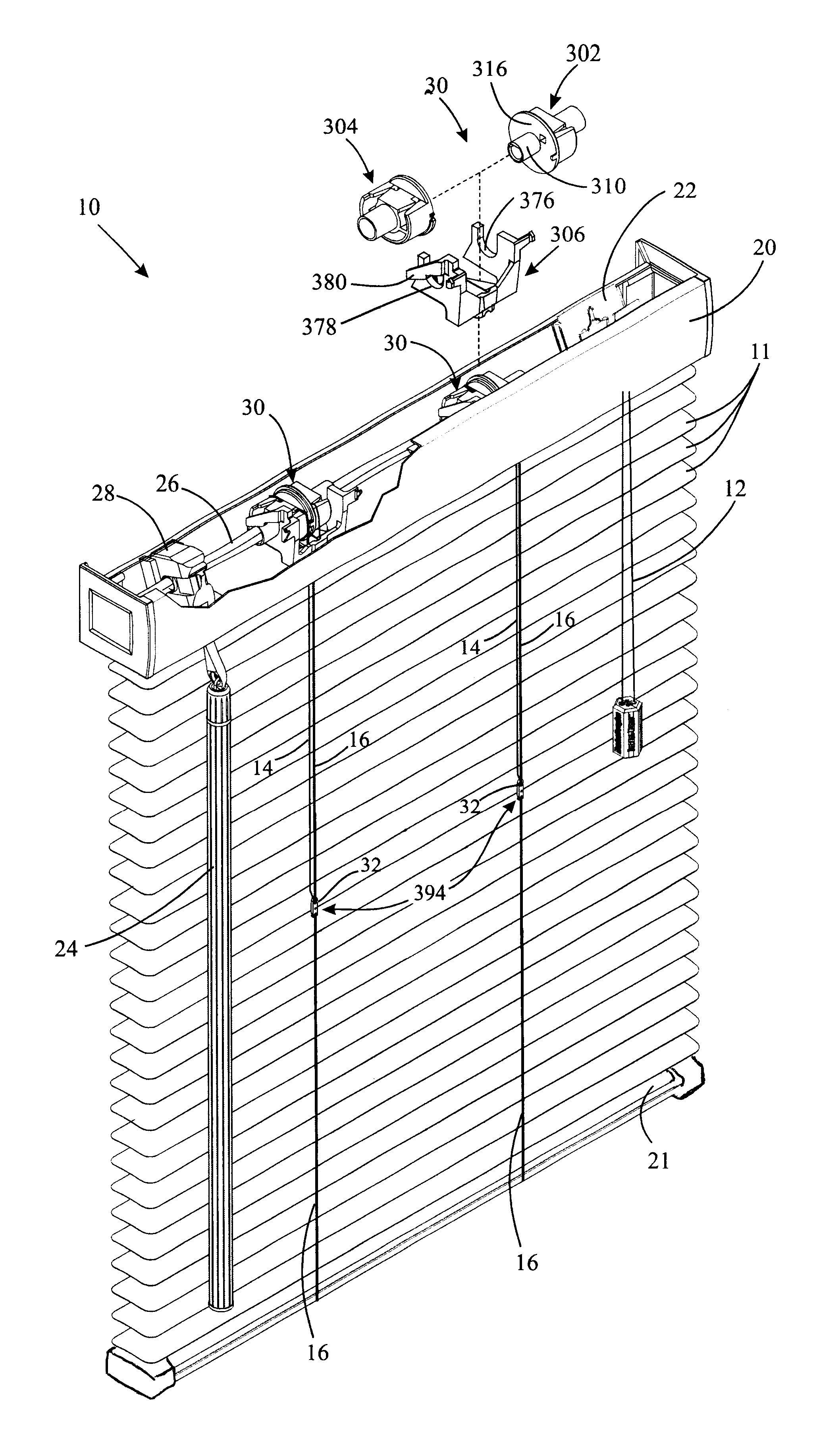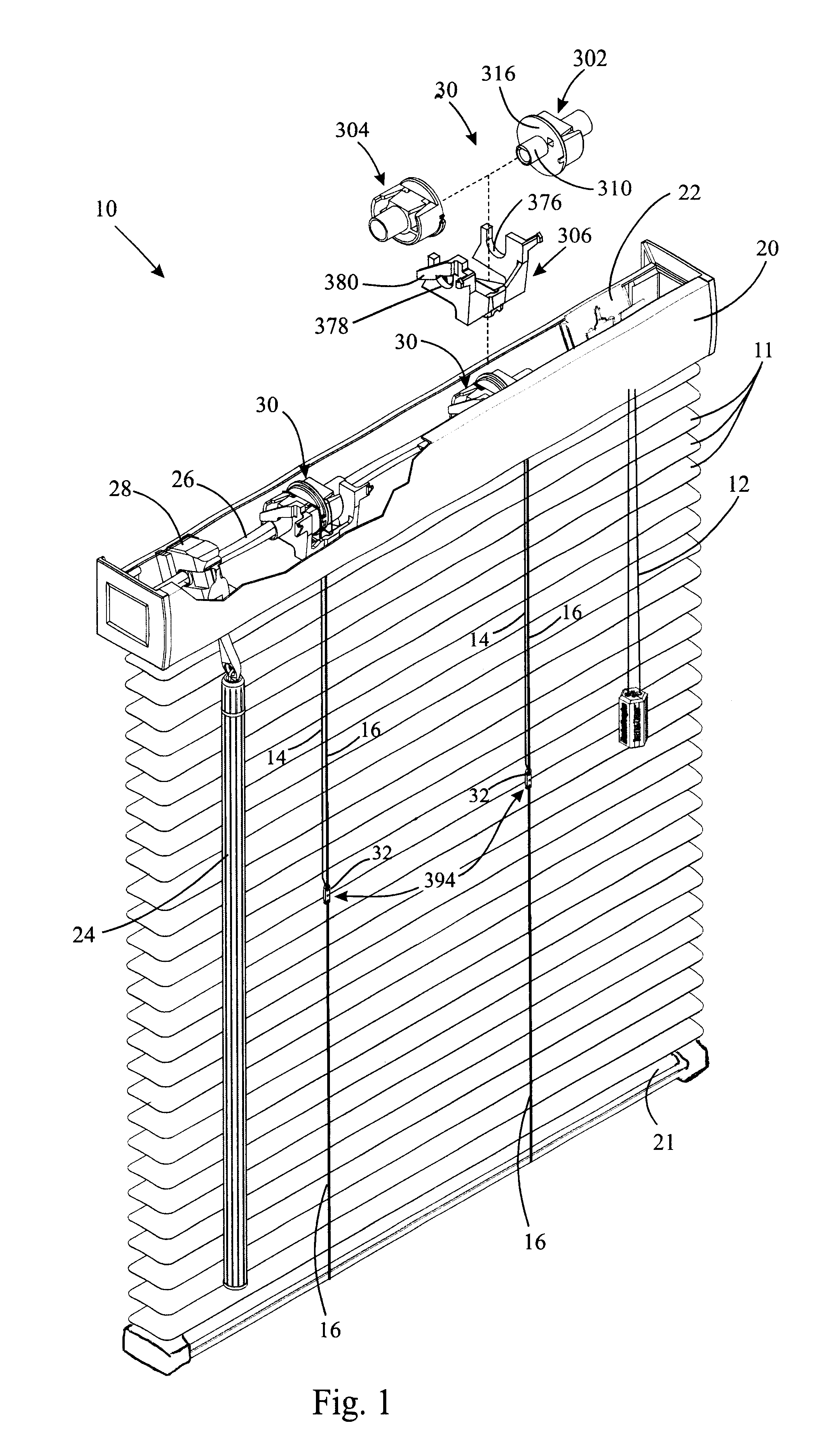Selective tilting arrangement for a blind system for coverings for architectural openings
a blind system and tilting arrangement technology, applied in the field of horizontal blinds, can solve the problems of undesirable daylight gap at the bottom of the blind, cord tangling, and people from the outside not being able to effectively see insid
- Summary
- Abstract
- Description
- Claims
- Application Information
AI Technical Summary
Benefits of technology
Problems solved by technology
Method used
Image
Examples
first embodiment
For ease in description, alternate embodiments of mechanisms for selectively tilting portions of a blind will be described by comparing and contrasting them with the first embodiment previously described and schematically illustrated in FIGS. 12A, 12B, and 12C. The cradle 306 has been deleted from all views, but it is understood that the cradle 306 would be present and would be providing the support for rotation and the limit stops, as required, when so indicated. In order to obtain further clarity and brevity in the description, all figures henceforth (where applicable) refer to front tilt cables 16a and rear tilt cables 16b, front actuator cables 14a and rear actuator cables 14b, and upper ladder tapes 18a and lower ladder tapes 18b, where front refers to the room side of the blind 10 and back refers to the window or wall side of the blind 10. (Of course, the directions front, back, left, right, etc. could be reversed in any embodiment without changing the functioning of the blind...
second embodiment
In this second embodiment, the front tilt cable 16A is secured to the head rail 20 (See FIG. 13B), the rear tilt cable 16B is secured to the rear slotted opening 348B of the tape drum 30A and extends only as far as the “break” point 394, where it is terminated. The actuator cord 14B is secured to the front slotted opening 328B and extends all the way to the bottom rail 21. The actuator cord 14B is secured to the bottom rail 21 in a similar manner as the front tilt cable 16A is secured to the bottom rail 21. The actuator cord 14B is also secured to all the ladders 17 supporting the slats 11 located at or below the break point 394 but is not connected to any of the ladders 17 supporting the slats 11 located above the break point 394. So, the actuator cord 14B effectively is one of the tilt cables for the lower portion of the blind.
The lengths of the tilt cables 16A, 16B and of the actuator cord 14B are adjusted so that, when the tape drum 30A is fully rotated clockwise (as seen from t...
fifth embodiment
The projection 322 on the drive drum 302 no longer has to “jump” over the detent on the driven drum 304D, since there is no longer a detent 356 on the driven drum 304D in this As a result, the user no longer experiences a sharp increase in force to engage or disengage the driven drum 304D.
FIGS. 26A, 26B, and 26C depict a sixth embodiment 10E of a blind manufactured in accordance with the present invention. This embodiment 10E is identical in its components to the first embodiment 10 onto the fifth embodiment 10D described above. The difference is that the actuator cord 14 in this sixth embodiment 10E is secured to the rear tilt cable instead of to the front tilt cable. The net effect is that, in one position of the tape drum 30D, when it is rotated fully in the counter-clockwise direction (as seen from the vantage point of FIG. 26C), the actuator cord 14 pulls up on the rear tilt cable 16 at the break point 394, resulting in the lower portion of the blind 30D being closed room side...
PUM
 Login to view more
Login to view more Abstract
Description
Claims
Application Information
 Login to view more
Login to view more - R&D Engineer
- R&D Manager
- IP Professional
- Industry Leading Data Capabilities
- Powerful AI technology
- Patent DNA Extraction
Browse by: Latest US Patents, China's latest patents, Technical Efficacy Thesaurus, Application Domain, Technology Topic.
© 2024 PatSnap. All rights reserved.Legal|Privacy policy|Modern Slavery Act Transparency Statement|Sitemap



